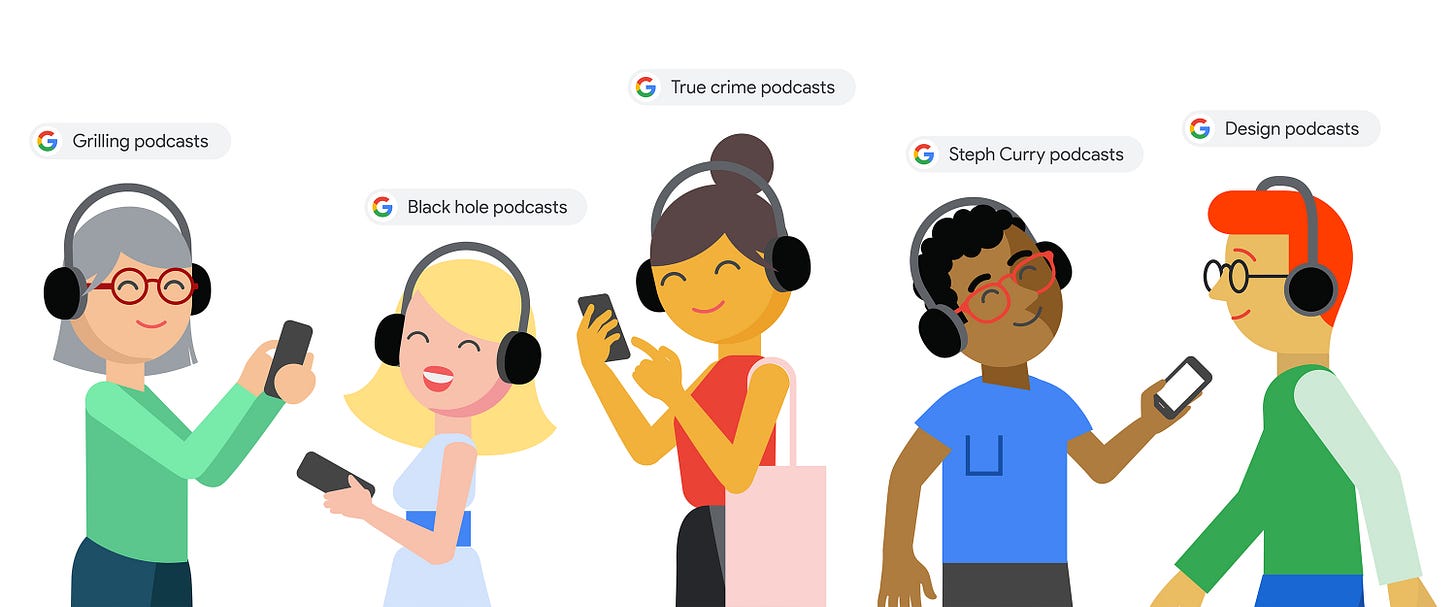3 Things: Windshield Wipers for Laptops, Jasper for Technical Content, Podcast Search
Happy Sunday and a very warm welcome to all the new subscribers! I’m thrilled and honored to have you as readers and truly appreciate your thoughts and feedback 🙏. Each edition of 3 Things will contain a dive into 3 rabbit holes I’ve found myself going down recently and associated business opportunities. Subscribe to get each week’s edition straight to your inbox and if you enjoy it, please share (I suck at self-promotion so can use your help)! This past week I’ve been thinking a lot about:
Windshield Wipers for Laptops
Jasper for Technical Content
Podcast Search
1. Windshield Wipers for Laptops
Sometimes the simplest things that seem almost silly turn out to be wildly huge businesses. In the 1980s, Steve Hartman, the CEO and President of Industrial Thermal Polymers got an interesting idea — what if they took the black and grey foam backer rods that they manufactured and made them colorful? He and his brothers were always playing around with them in the pool and he thought others would get a kick out of them too. Sales started off slow but after Canadian Tire started carrying the colorful rods, soon his company was selling 6-8 million pool noodles (aka “water woggles”) a year! Who would have thought such a simple, silly item would turn into a large business. Similarly, would you believe me if I told you that PopSockets does over $170m in revenue? Yes, those little circles that you pop out on the back of your phone that started off as a life hack to control tangled headphones now sells well over 10 million units a year at $10 a pop. In 2017, there were over 19 million fidget spinners that were sold and back in the 1980s, Gary Dahl sold over 1.5 million pet rocks. Often people are trying to solve a personal pain point that ends up being way more ubiquitous than expected.
Now that we all live on video conferences, one constant annoyance for me is having to wipe off the front-facing camera which constantly gets smudged and dirty, making my video quality poor. There is already a market for laptop camera covers that are wildly popular for privacy and security reasons. In a similar fashion, I think someone should make a mini “windshield wiper” that does double duty of covering your camera when you’re not using it and then cleaning the lens when you open it. You could have fun with it and make it look like a real windshield wiper and even have a little button that you push at the top which caused it to wipe the camera. The camera covers are often given out at conferences and events so these could similarly be branded and become the new hot giveaway. I would imagine these would be extremely cheap to manufacture in bulk so could generate pretty high margins.
2. Jasper for Technical Content
If you work in tech and even remotely follow all the developments in AI, you’ve likely heard of Jasper (and probably many competitors like Copy.ai, Copysmith, Writesonic, etc). The company launched their current product in 2021 after running an agency for a few years doing website personalization. When GTP-3 came out, they took their existing business and turned it a product that uses AI to generate all types of marketing copy; from blog posts to emails to ad copy. They company has grown insanely fast and was reported to do $40m+ revenue in 2021 and growing 100% YoY for 2022. In October of 2022, the company raised a $125m round valuing them at $1.5B.
AI copywriting tools is already an extremely crowded market that will only get more competitive, and today these solutions have grown almost 100% through a self-serve product focused on generic marketing or social copy. They provide a wrapper and UI around foundation models like GPT-3 but ultimately struggle to do anything that is specialized, like technical content. For technical content, you’d want a model that is fine-tuned on a corpus of code samples, previous examples of technical writing, and developer Q&A ala StackOverflow. Just as we are seeing a ton of companies starting to focus on building AI-driven copy solutions for outbound sales use cases (ex. Regie, Octave, SellScale, etc), I think there is an opportunity to focus on technical content. The product would need to be a combination of a fine-tuned Jasper plus a bit of Github Copilot. Additionally, imagery for technical content often includes code snippets in the creative which is extremely hard to do with the existing off-the-shelf image generation models. Since many dev tools, infrastructure, and other extremely technical companies spend a ton of time and money on content marketing (developer relations, community/education, SEO content for discovery), you’d have a huge audience who’d be much more likely to use this product over a generic one.
3. Podcast Search
Audio search has been a struggle forever. Once you turn audio to text, it’s a solved problem, but prior to a few years ago, speech-to-text algorithms weren’t good enough, and it was too expensive to transcribe the entire corpus of audio content to make it searchable. There are currently over 3 million unique active podcasts which translates into over a billion minutes of audio published every year. As of 2022, around 73% of Americans, or 209 million people, listen to online audio every month with 177 million listening to podcasts. The vast majority of people (74%) listen to podcasts to learn something, but discovery is still done primarily by word of mouth and it’s often more reactive than proactive when it comes to subject as the nature of RSS is to subscribe to a feed and get whatever the creator publishes. The existing popular podcast apps like Apple, Spotify, and Google are all pretty atrocious when it comes to search and discovery which continues to irk podcast enthusiasts.
There are external podcast search engines like Listen Notes or PodSearch but they often are just returning matches based on podcast name or episode title. Additionally, a few years ago, Google had announced that they were going to start indexing audio and adding deep links to YouTube snippets in search results, but that doesn’t seem to have gotten very far and also focuses much more on video than audio. With the new advances in chat-based search like ChatGPT, Bard, and new Bing, you can now ask a chat interface any question you want and it will return a generally well written (though not always 100% accurate 😂) synthesized answer. I’m constantly listening to podcasts to learn about a specific topic, from a specific expert, or to keep up with news but it’s still nearly impossible to go back and reference something I heard on a podcast or find further information on a subject. We now use voice assistants like Alexa and Google Home to answer a lot of our questions but often, I’m not just looking for a simple answer like “what is the temperature outside” — I want to listen to discussion on a topic or related to a question. I think it will soon be possible to build a useful podcast search engine that will allow a user to ask very specific questions and return an audio clip, taken from existing published content, that contains the best answer. It could even see this being a standalone app that people use specifically when they’re in learn or question/answer mode.
That’s all for today! If you have thoughts, comments, or want to get in touch, find me on Twitter at @ezelby and if you enjoyed this, please subscribe and share with a friend or two!
~ Elaine
And in case you like podcasts…
From scrap metal to timber, estate planning to freight pooling, the new (un)sexy podcast is a meandering exploration of just how sexy unsexy industries can be.
Join us weekly as we uncover stories of niche and esoteric markets, understanding their history and looking at the future through the eyes of the pioneering entrepreneurs willing to bring technology and exponential improvements to these often overlooked spaces.
Listen now on Spotify, Apple, Google, or wherever you listen to podcasts.






